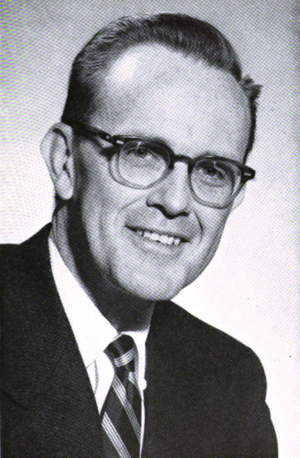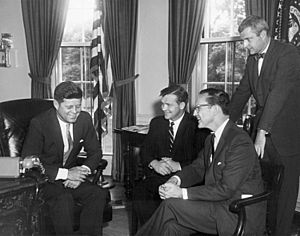Philip Hart facts for kids
Quick facts for kids
Philip Hart
|
|
|---|---|
 |
|
| United States Senator from Michigan |
|
| In office January 3, 1959 – December 26, 1976 |
|
| Preceded by | Charles E. Potter |
| Succeeded by | Donald Riegle |
| 51st Lieutenant Governor of Michigan | |
| In office January 1, 1955 – January 1, 1959 |
|
| Governor | G. Mennen Williams |
| Preceded by | Clarence A. Reid |
| Succeeded by | John Swainson |
| Personal details | |
| Born |
Philip Aloysius Hart
December 10, 1912 Bryn Mawr, Pennsylvania, U.S. |
| Died | December 26, 1976 (aged 64) Washington D.C., U.S. |
| Political party | Democratic |
| Spouse | |
| Children | 9 |
| Alma mater | Georgetown University University of Michigan Law School |
| Profession | Attorney |
| Military service | |
| Allegiance | |
| Branch/service | |
| Years of service | 1941–1946 |
| Rank | |
| Unit | 4th Infantry Division |
| Battles/wars | World War II |
| Awards | Purple Heart |
Philip Aloysius Hart (December 10, 1912 – December 26, 1976) was an American lawyer and politician. He was a member of the Democratic Party. He served as a U.S. Senator for Michigan from 1959 until he passed away in 1976. People often called him the "Conscience of the Senate" because he was known for his strong moral compass. The Hart Senate Office Building in Washington, D.C., is named after him.
Contents
Early Life and Family
Philip Hart was born in Bryn Mawr, Pennsylvania. His father was a banker. Philip went to Waldron Mercy Academy and West Philadelphia Catholic High School.
He later studied at Georgetown University in Washington, D.C. There, he was the student body president and a great debater. He earned his first degree from Georgetown in 1934 with honors. In 1937, he received his law degree from the University of Michigan Law School.
In 1943, Hart married Jane "Janey" Briggs. Her father, Walter Briggs, owned the Detroit Tigers baseball team. Jane was a pioneering aviator and the first female helicopter pilot in Michigan. She was also part of the Mercury 13 group, women who trained to be astronauts in the 1960s. Philip and Jane had nine children, but one son, Philip Jr., died when he was very young.
Early Career and Military Service
In 1938, Hart became a lawyer in Detroit, Michigan. When World War II began, he joined the U.S. Army. He served as a lieutenant colonel with the 4th Infantry Division from 1941 to 1946.
During the D-Day invasion of Normandy, he was injured on Utah Beach. A piece of an exploding shell hurt his right arm. After the war, he recovered in Michigan. He met other future U.S. senators, Bob Dole and Daniel Inouye, at the hospital. Hart received several awards for his service, including the Purple Heart.
After the war, Hart returned to practicing law. He became active in the Democratic Party. From 1949 to 1951, he worked for Michigan as the Corporation Securities Commissioner. He helped approve stock issues and licensed real estate brokers. He also served as the state director for the Office of Price Stabilization for a year.
In 1952, he became a U.S. Attorney for Eastern Michigan. From 1953 to 1954, he advised Governor G. Mennen Williams. In 1954, Hart was elected as the 51st lieutenant governor of Michigan. He served two terms until 1959. He was the first Democrat in Michigan to serve two terms in that role.
Serving in the U.S. Senate

In 1958, Philip Hart was elected as a U.S. Senator for Michigan. He won by a good margin against the Republican Senator Charles E. Potter. He was reelected easily in 1964 and 1970. His 1970 opponent was Lenore Romney, the former First Lady of Michigan. Some people tried to remove Hart from office because of his views on gun control and school integration. However, the U.S. Constitution does not allow federal officials to be recalled.
Senator Hart was a main supporter of the Immigration and Nationality Act of 1965. This important law, also known as the Hart-Celler Act, ended old rules that limited immigration from many parts of the world. These rules had been in place since 1924.
Hart decided not to run for reelection in June 1976. A month later, he was diagnosed with cancer. The Senate voted to name its new office building after him, even though he was still alive. This was a rare honor. The vote was 99-0, with Hart not voting. He passed away from melanoma a few days later, just before his term ended. Donald W. Riegle, Jr., who had just been elected to the seat, filled Hart's position for the last few days of the session.
Philip Hart is buried in St. Anne's Catholic Cemetery on Mackinac Island. He rests near his young son, Philip Jr.
Honors and Legacy
- In 1982, the Hart Senate Office Building was officially named in his honor. It is the third Senate office building.
- Other places named after Hart include the Hart–Dole–Inouye Federal Center in Battle Creek, Michigan. There is also the Philip A. Hart Plaza in Detroit. The Philip A. Hart Visitor Center at Sleeping Bear Dunes National Lakeshore is also named for him.
- Hart Middle School in Rochester Hills, Michigan, and the Hart-Kennedy House in Lansing (headquarters of the Michigan Democratic Party) also carry his name.
- A scholarship, the Philip Hart Memorial Scholarship, was created at Lake Superior State University. It helps students who show the same ideals as Senator Hart.
- The moot court room at Georgetown University Law Center is named in his honor.
Author Ronald Kessler praised Senator Hart in his book Inside Congress. He wrote that Hart was one of the few truly honorable people in the Senate. He even mentioned that Hart would not accept gifts, not even a box of chocolates, from lobbyists.
See also
- List of United States Congress members who died in office (1950–99)

